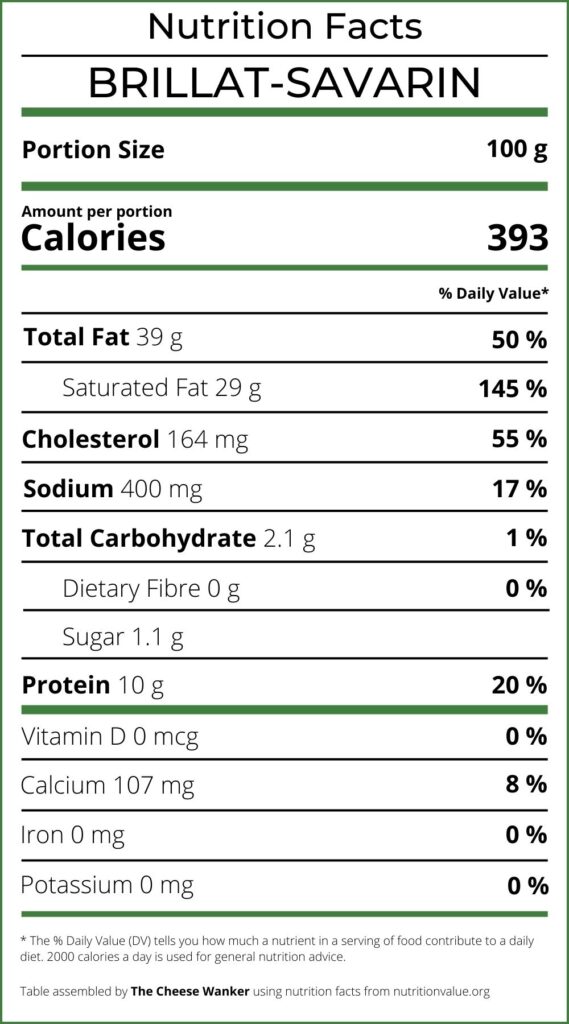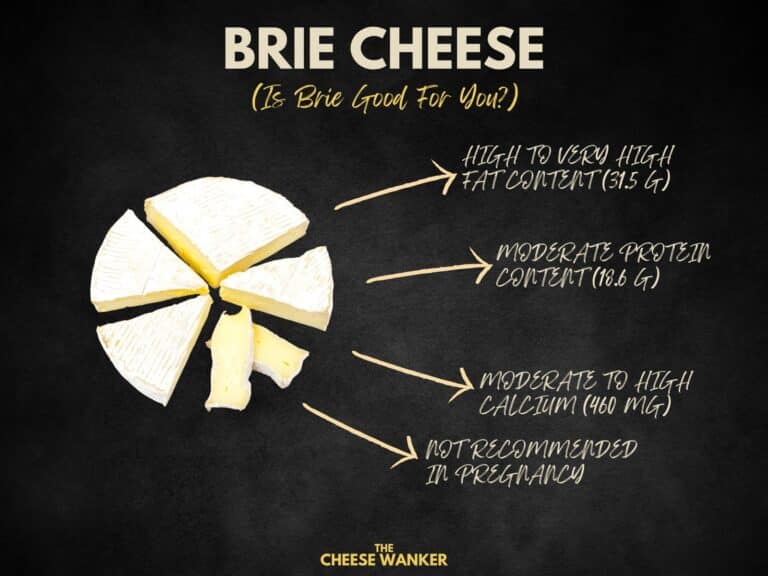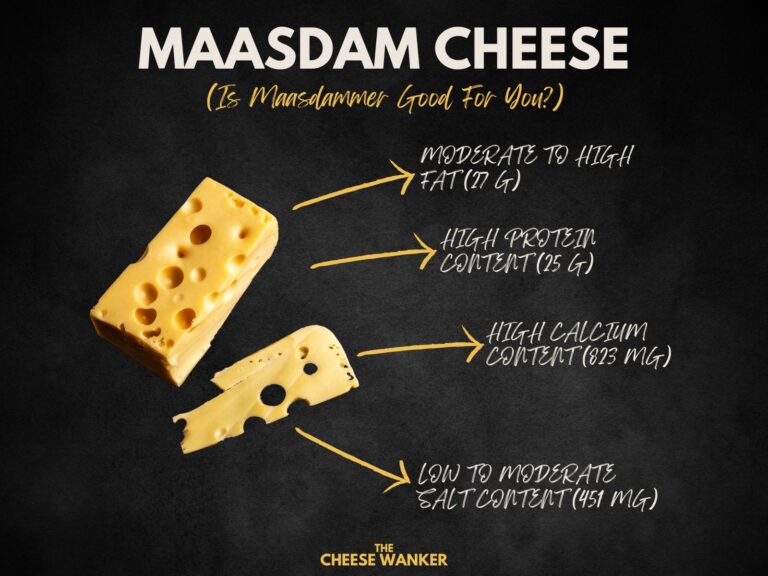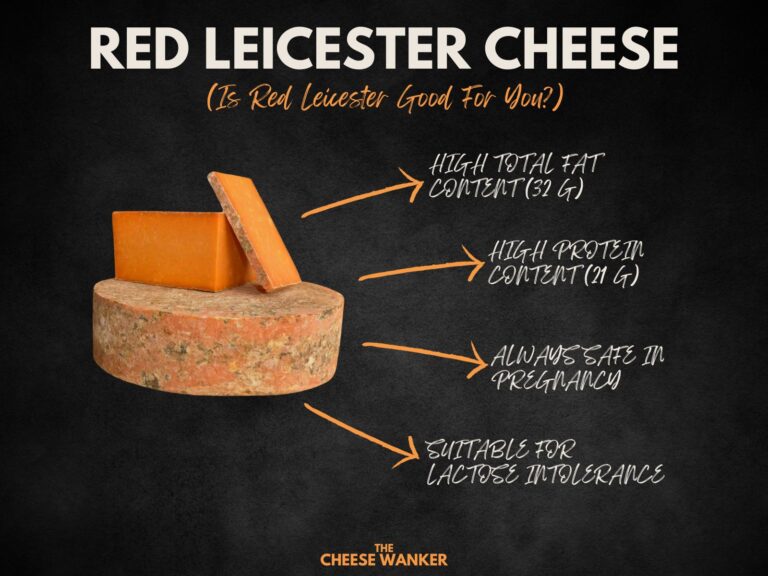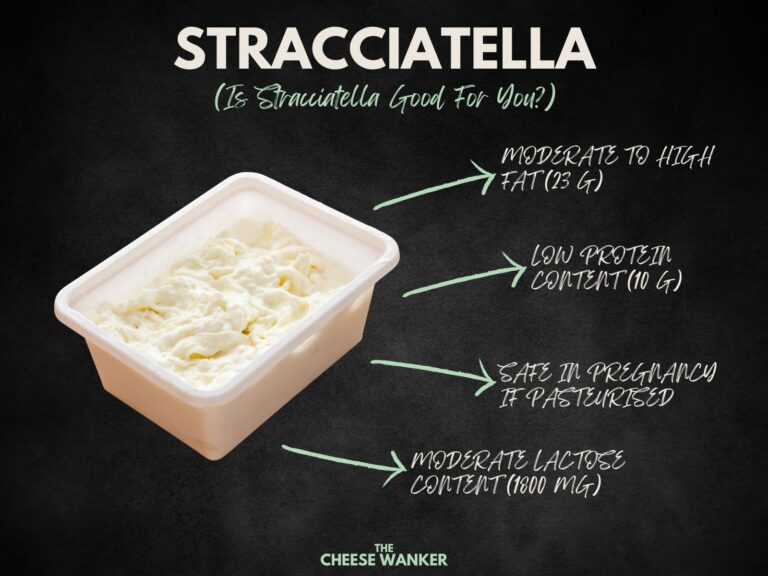Nestled within the heart of France, Brillat-Savarin cheese is renowned for its rich and creamy texture. Yet, beyond its delectable taste, the cheese holds a wealth of nutritional secrets waiting to be explored. In this blog post, we delve deep into the nutrition facts of Brillat-Savarin.
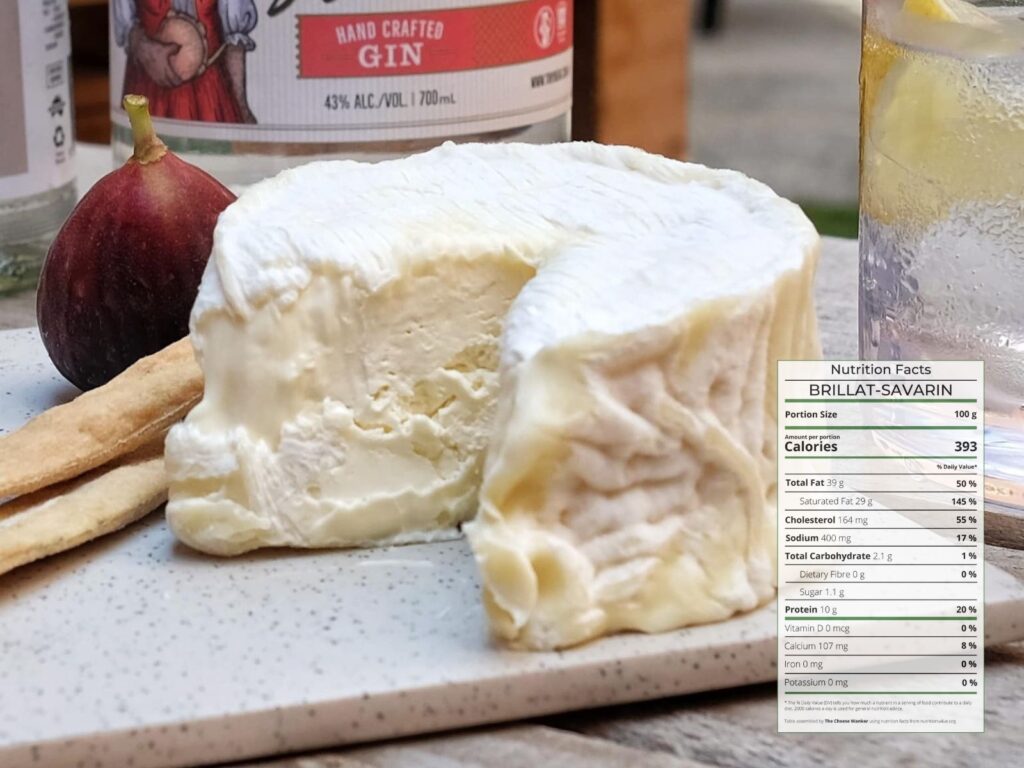
SEE ALSO: Nutrition facts for popular world cheeses in The Cheese Wanker’s index →
What is Brillat-Savarin?
Brillat-Savarin is a decadent triple cream cheese named after the esteemed gastronome Jean Anthelme Brillat-Savarin. Crafted with meticulous care, this hugely popular cheese boasts a snowy white, bloomy rind that encapsulates its velvety, pale interior.
Its delicate aroma hints at the fresh milk used in its making, while the taste profile is a harmonious blend of sweetness, creaminess and a subtle tang, evolving in complexity as it matures.
When it comes to serving Brillat-Savarin, the possibilities are as rich as its taste. Whether elegantly arranged on a cheese platter or incorporated into culinary creations, Brillat-Savarin elevates any gastronomic experience.
Nutrition fact sheet
Country of origin
France
Type of Cheese
Soft White Mould (Triple Cream)
Milk
Cow (Pasteurised)
Examples
Brillat-Savarin Frais, Brillat-Savarin Affiné, Petit Format (250 g), Grand Format (500 g)
Benefits
Moderate to High Protein Content, Moderate to High Calcium Content
Considerations
Milk Protein Intolerance, Very High Fat Content, Low to Moderate Lactose Levels, Moderate to High Salt Content, Pregnancy (Not Recommended)
Nutritional review for Brillat-Savarin
Eating healthy plays a pivotal role in maintaining overall well-being and preventing chronic diseases. A balanced and nutritious diet provides our bodies with essential vitamins, minerals, and macronutrients, fuelling optimal physical and cognitive function.
With this in mind, let’s have a look at some of the key nutrition facts for Brillat-Savarin.
Calorie Count
At 393 calories per 100g serving, Brillat-Savarin cheese stands as a testament to its rich, creamy nature. Calories, traditionally viewed as a measure of energy derived from food, have long been a fundamental metric in understanding the nutritional content of a dish.
However, in the evolving landscape of nutrition, the sheer calorie count is now seen through a more nuanced lens. While excessive calorie consumption can contribute to weight-related issues, it is essential to recognise that not all calories are created equal.
The source of these calories matters significantly. For instance, Brillat-Savarin, although calorie-dense, derives its calories primarily from fats and proteins, both of which play crucial roles in the body’s functions.
Fat Content
Brillat-Savarin, with its 39g of fat per 100g serving, challenges traditional notions about fats in our diet. The understanding of fats has evolved, recognising the diversity of fats and their impact on health.
In the case of Brillat-Savarin, a significant portion of its fat content consists of healthy monounsaturated and polyunsaturated fats, essential for heart health and overall well-being.
These fats, when sourced from natural and minimally processed foods like cheese, serve as more than just an energy source; they become carriers of essential nutrients, aiding in the absorption of fat-soluble vitamins vital for various bodily functions.
You can learn more about the different types of fat in cheese and which cheeses have the lowest fat content here.
Protein Content
With 10g of protein per 100g serving, this triple cream delight is a notable dietary source of this essential nutrient. While slightly lower than some other cheeses, its protein content remains significant, supporting vital bodily functions like muscle maintenance, immune health, and appetite control.
The blend of casein and whey proteins in Brillat-Savarin underscores its value as a satisfying and nutritious choice, further emphasising the multifaceted benefits of proteins in our diet.
Despite its marginally lower protein content compared to some cheeses, Brillat-Savarin’s 10g of protein still contributes substantially to one’s daily protein intake. Proteins play a pivotal role in preserving lean muscle mass, making this cheese a valuable option.
Want to find out which cheeses have the highest protein content? Click here for our blog post covering cheeses with the highest protein content.
Cholesterol Content
The creaminess of Brillat-Savarin raises pertinent questions about the impact of dietary cholesterol on our health. Recent research challenges the conventional belief that all dietary cholesterol is inherently harmful.
While moderation remains key, the relationship between dietary cholesterol, particularly from natural sources like cheese, and its effect on blood cholesterol levels appears more complex than previously assumed.
Consequently, the 164 mg of cholesterol in Brillat-Savarin, when consumed as part of a balanced diet, might not have the detrimental impact once feared, especially when considering the cheese’s other nutritional benefits.
You can learn more about the impact of dietary cholesterol on blood cholesterol levels in our dedicated post here.
Salt Content
The salt content in Brillat-Savarin, measuring 400 mg per 100g serving, provides a fascinating glimpse into the world of culinary craftsmanship and dietary considerations.
Historically, salt has been instrumental in preserving cheeses, enhancing their flavours and ensuring their longevity. In Brillat-Savarin, salt not only contributes to its taste but also plays a pivotal role in maintaining its texture and safety.
From a health perspective, while salt is an essential mineral, excessive sodium intake poses concerns, particularly in relation to cardiovascular health. Brillat-Savarin’s sodium content reminds consumers of the significance of moderation.
Being mindful of sodium intake is especially vital for individuals with specific health conditions, like hypertension. Therefore, they need to consider the salt content in cheeses like Brillat-Savarin when planning their diets.
You can read more about why salt is important in cheesemaking in our comprehensive post here.
Calcium Content
Brillat-Savarin, containing 107 mg of calcium per 100g serving, offers a valuable source of this essential mineral. Calcium, crucial for bone health, nerve function and muscle contraction, is a vital nutrient in our diet.
Brillat-Savarin’s calcium content, though not exceptionally high, contributes to the overall dietary intake of this essential mineral. While the cheese may not be a primary source, it serves as a valuable addition to the diet, especially for individuals with limited access to other calcium-rich foods.
For individuals who may be lactose intolerant or have specific dietary restrictions, incorporating calcium-rich cheeses into their diet can be an excellent alternative to meet their calcium needs.
Get our complete guide to calcium content in cheese in this post here.
Safety in Pregnancy
Pregnancy is a time when dietary choices significantly impact both maternal health and foetal development. When it comes to Brillat-Savarin, its safety during pregnancy requires careful consideration.
Due to its high moisture content and white mould rind, Brillat-Savarin becomes a potential breeding ground for harmful bacteria, particularly Listeria monocytogenes. This can lead to serious complications including miscarriage or severe illnesses in newborns.
Health authorities, such as FDA and FSANZ, advise pregnant women to avoid soft white mould cheeses, including Brillat-Savarin, even if labelled as pasteurised.
While Brillat-Savarin’s luxurious texture may tempt, the prudence lies in avoiding it during pregnancy. Prioritising food safety ensures a healthy pregnancy journey, safeguarding both the mother and the unborn child from potential risks.
Of course, if you’re unsure of what you can eat during pregnancy, you should consult your healthcare professional to get a personalised plan. You can read more about which cheeses you can eat when you’re pregnant by clicking here.
Lactose Intolerance
Finally, Brillat-Savarin’s lactose content is slightly higher than matured cheeses yet lower than fresh varieties. Hence, its suitability for lactose-intolerant cheese lovers warrants an interesting discussion.
While lactose intolerance varies widely among individuals, Brillat-Savarin’s composition places it in a unique position. Its lower lactose content compared to fresh cheeses makes it more tolerable for many lactose-intolerant individuals.
Coupled with its richness, this positions Brillat-Savarin as an option for those seeking a balance between indulgence and digestive comfort. For those mildly lactose intolerant, this cheese might still be enjoyed in moderation without severe discomfort.
Conclusion
In the delightful realm of decadent cheeses, Brillat-Savarin stands as a testament to the intricate fusion of taste, tradition and nutrition. Understanding Brillat-Savarin’s nutrition facts is not just about deciphering figures; it’s about appreciating the delicate balance between culinary artistry and health consciousness.
Comprehending the nutrition facts of Brillat-Savarin extends beyond numerical values; it exemplifies the delicate equilibrium between gastronomic artistry and health-conscious discernment.
As discerning consumers, we are not passive observers but active participants in our dietary choices, wielding the capacity to make informed decisions in the pursuit of holistic well-being. Whether savoured on exceptional occasions or integrated into daily culinary pursuits, Brillat-Savarin prompts us to embrace the essence of enlightened gastronomy.
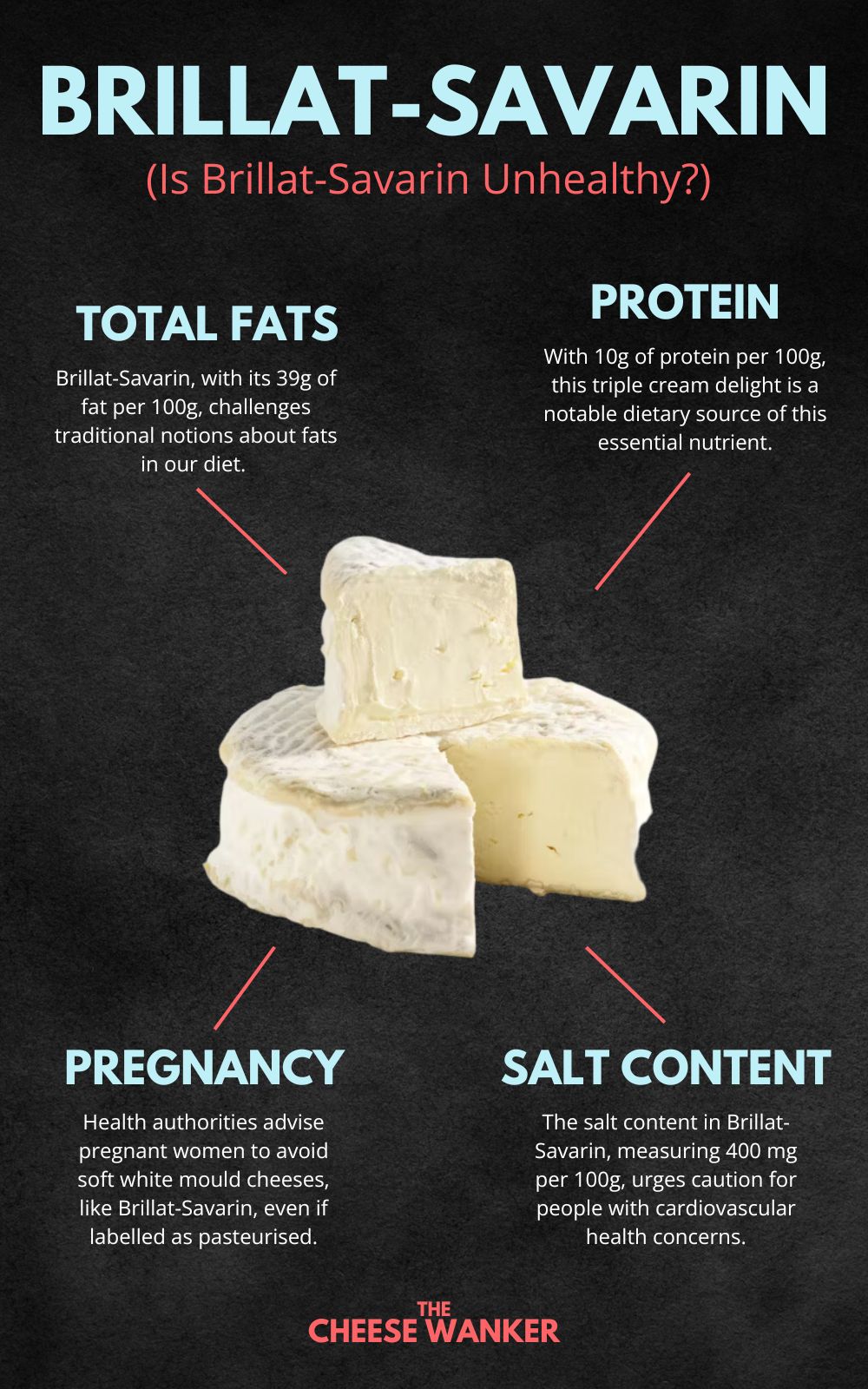
References
Nutritional content
The nutritional content of cheese in our table comes from the USDA Food Data Central Repository and cheese manufacturers. We realise that there can be variations between different brands and producers. Hence, the numbers we have used are averages.
Fat
Our fat RDI data comes from Cleveland Clinic’s Healthy Fat Intake resource.
Type of fat in cheese as per Harvard T.H. Chan’s The Nutrition Source.
Protein
Our protein RDI data comes from Harvard Medical School’s Harvard Health Publishing.
Cholesterol
Is There a Correlation between Dietary and Blood Cholesterol? Evidence from Epidemiological Data and Clinical Interventions? – Maria Luz Fernandez and Ana Gabriela Murillo
Saturated fat, carbohydrate, and cardiovascular disease – Patty W Siri-Tarino, Qi Sun, Frank B Hu and Ronald M Krauss
Effect of cheese consumption on blood lipids: a systematic review and meta-analysis of randomized controlled trials – Janette de Goede, Johanna M Geleijnse, Eric L Ding, Sabita S Soedamah-Muthu
Safety in Pregnancy
All the advice relating to what cheeses you can eat during pregnancy in this article is based on the recommendations by health authorities in Australia, the UK and the USA. If you are unsure about what you can or cannot eat, please consult your doctor.
Australia – FSANZ, United Kingdom – NHS and United Sates of America – FDA
Lactose Content
Lactose residual content in PDO cheeses
Detection of lactose in products with low lactose content
The analysis of lactose in milk and cheese products by HPLC
Food Standards ANZ Food Composition Database
Lactose & Galactose content of cheese
